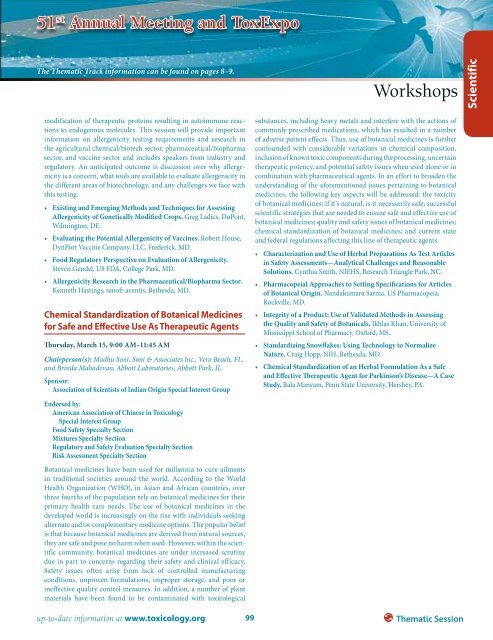51st Annual Meeting & ToxExpo - Society of Toxicology
51st Annual Meeting & ToxExpo - Society of Toxicology
51st Annual Meeting & ToxExpo - Society of Toxicology
Create successful ePaper yourself
Turn your PDF publications into a flip-book with our unique Google optimized e-Paper software.
51 st <strong>Annual</strong> <strong>Meeting</strong> and <strong>ToxExpo</strong><br />
The Thematic Track information can be found on pages 8–9.<br />
Workshops<br />
Scientific<br />
modification <strong>of</strong> therapeutic proteins resulting in autoimmune reactions<br />
to endogenous molecules. This session will provide important<br />
information on allergenicity testing requirements and research in<br />
the agricultural chemical/biotech sector, pharmaceutical/biopharma<br />
sector, and vaccine sector and includes speakers from industry and<br />
regulatory. An anticipated outcome is discussion over why allergenicity<br />
is a concern, what tools are available to evaluate allergenicity in<br />
the different areas <strong>of</strong> biotechnology, and any challenges we face with<br />
this testing.<br />
• Existing and Emerging Methods and Techniques for Assessing<br />
Allergenicity <strong>of</strong> Genetically Modified Crops. Greg Ladics, DuPont,<br />
Wilmington, DE.<br />
• Evaluating the Potential Allergenicity <strong>of</strong> Vaccines. Robert House,<br />
DynPort Vaccine Company, LLC, Frederick, MD.<br />
• Food Regulatory Perspective on Evaluation <strong>of</strong> Allergenicity.<br />
Steven Gendel, US FDA, College Park, MD.<br />
• Allergenicity Research in the Pharmaceutical/Biopharma Sector.<br />
Kenneth Hastings, san<strong>of</strong>i-aventis, Bethesda, MD.<br />
Chemical Standardization <strong>of</strong> Botanical Medicines<br />
for Safe and Effective Use As Therapeutic Agents<br />
Thursday, March 15, 9:00 AM–11:45 AM<br />
Chairperson(s): Madhu Soni, Soni & Associates Inc., Vero Beach, FL,<br />
and Brinda Mahadevan, Abbott Laboratories, Abbott Park, IL.<br />
Sponsor:<br />
Association <strong>of</strong> Scientists <strong>of</strong> Indian Origin Special Interest Group<br />
substances, including heavy metals and interfere with the actions <strong>of</strong><br />
commonly prescribed medications, which has resulted in a number<br />
<strong>of</strong> adverse patient effects. Thus, use <strong>of</strong> botanical medicines is further<br />
confounded with considerable variations in chemical composition,<br />
inclusion <strong>of</strong> known toxic components during the processing, uncertain<br />
therapeutic potency, and potential safety issues when used alone or in<br />
combination with pharmaceutical agents. In an effort to broaden the<br />
understanding <strong>of</strong> the aforementioned issues pertaining to botanical<br />
medicines, the following key aspects will be addressed: the toxicity<br />
<strong>of</strong> botanical medicines; if it’s natural, is it necessarily safe; successful<br />
scientific strategies that are needed to ensure safe and effective use <strong>of</strong><br />
botanical medicines; quality and safety issues <strong>of</strong> botanical medicines;<br />
chemical standardization <strong>of</strong> botanical medicines; and current state<br />
and federal regulations affecting this line <strong>of</strong> therapeutic agents.<br />
• Characterization and Use <strong>of</strong> Herbal Preparations As Test Articles<br />
in Safety Assessments—Analytical Challenges and Reasonable<br />
Solutions. Cynthia Smith, NIEHS, Research Triangle Park, NC.<br />
• Pharmacopeial Approaches to Setting Specifications for Articles<br />
<strong>of</strong> Botanical Origin. Nandakumara Sarma, US Pharmacopeia,<br />
Rockville, MD.<br />
• Integrity <strong>of</strong> a Product: Use <strong>of</strong> Validated Methods in Assessing<br />
the Quality and Safety <strong>of</strong> Botanicals. Ikhlas Khan, University <strong>of</strong><br />
Mississippi School <strong>of</strong> Pharmacy, Oxford, MS.<br />
• Standardizing Snowflakes: Using Technology to Normalize<br />
Nature. Craig Hopp, NIH, Bethesda, MD.<br />
• Chemical Standardization <strong>of</strong> an Herbal Formulation As a Safe<br />
and Effective Therapeutic Agent for Parkinson’s Disease—A Case<br />
Study. Bala Manyam, Penn State University, Hershey, PA.<br />
Endorsed by:<br />
American Association <strong>of</strong> Chinese in <strong>Toxicology</strong><br />
Special Interest Group<br />
Food Safety Specialty Section<br />
Mixtures Specialty Section<br />
Regulatory and Safety Evaluation Specialty Section<br />
Risk Assessment Specialty Section<br />
Botanical medicines have been used for millennia to cure ailments<br />
in traditional societies around the world. According to the World<br />
Health Organization (WHO), in Asian and African countries, over<br />
three fourths <strong>of</strong> the population rely on botanical medicines for their<br />
primary health care needs. The use <strong>of</strong> botanical medicines in the<br />
developed world is increasingly on the rise with individuals seeking<br />
alternate and/or complementary medicine options. The popular belief<br />
is that because botanical medicines are derived from natural sources,<br />
they are safe and pose no harm when used. However, within the scientific<br />
community, botanical medicines are under increased scrutiny<br />
due in part to concerns regarding their safety and clinical efficacy.<br />
Safety issues <strong>of</strong>ten arise from lack <strong>of</strong> controlled manufacturing<br />
conditions, unproven formulations, improper storage, and poor or<br />
ineffective quality control measures. In addition, a number <strong>of</strong> plant<br />
materials have been found to be contaminated with toxicological<br />
up-to-date information at www.toxicology.org 99<br />
Thematic Session
















